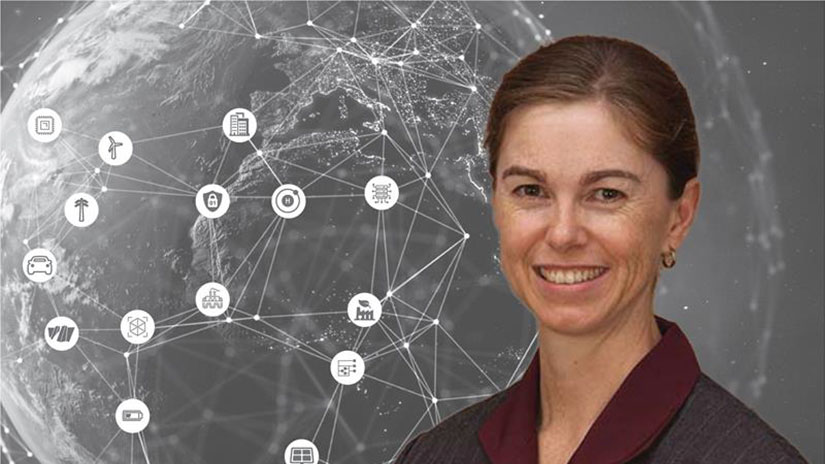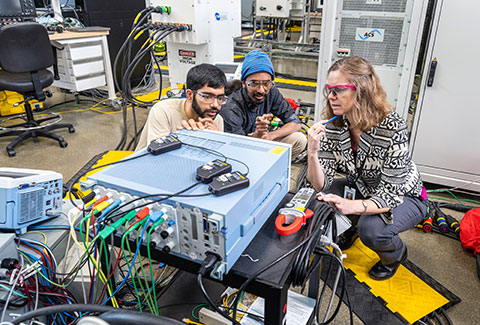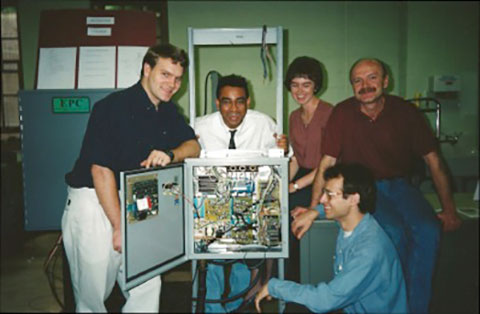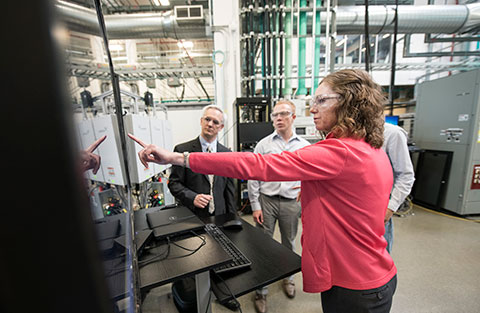ARIES: Solutions at any Scale
Q&A With Annabelle Pratt: Using the Beauty of Mathematics To Answer Utility Challenges
Welcome to the ARIES: Solutions at Any Scale series. This Q&A series introduces NREL’s outstanding researchers working on Advanced Research on Integrated Energy Systems (ARIES) projects. Their work helps answer questions about future energy systems for communities, companies, and energy leaders—from single technologies, to the impact of large-scale deployments, to entire regional grid systems.


Annabelle Pratt is a chief engineer in NREL’s Power Systems Engineering Center whose motivation for her work runs deep.
“My motivation to work on power systems comes from my belief that electricity is such an essential utility for human life and flourishing,” Pratt said. “I contribute a small piece to the bigger picture of delivering electricity to people.”
Pratt’s engineering interests were not sparked by hands-on things like electric motors or vehicles but by mathematics.
“My two older brothers were engineers, and they encouraged me to become an engineer,” she said. “I always liked math, and to me, even to this day, linear control systems are the most mathematically beautiful expressions of control. I’ve never really reflected on why I like control systems, but I guess it boils down to the math.”
In this interview, we learn how Pratt turned math into a career in energy and why ARIES offers a leap forward for her research. This interview has been edited for clarity and length.
What was your path like to becoming a power systems engineer?

Annabelle Pratt works on a motor drive in graduate school at Oregon State University. Photo from Annabelle Pratt
I am an electrical engineer who specialized in power electronics. As an undergraduate student, I fell in love with control systems, but I thought that it would be beneficial to get some exposure to power systems, and in the process, I discovered the field of power electronics. It is a multidisciplinary field where you bring your knowledge of controls systems, signal processing, electronics, and electromagnetics together to build a motor drive or power supply. While pursuing my master’s degree, I worked on active power filters for power systems, which was my first exposure to power electronics applied to power systems.
I grew up in South Africa, and that is where I received my bachelor’s and master’s degrees, but then I had the opportunity to come to the United States for my Ph.D. It seemed like such an adventure to come to the United States, so I came and continued my studies in the field of power electronics. During my Ph.D., I was an intern at Westinghouse where I was exposed to what they could do at the megawatt scale. (For reference: Most research is done at the kilowatt scale, and 1 MW of generation can power roughly 1,000 homes). It got my imagination going on the application of power electronics to power systems at a large scale. I then worked at a power supply company on power supplies for semiconductor manufacturing and then moved to Intel Corporation, where I worked on power delivery at different scales. Toward the end of my tenure at Intel, I moved to work on energy management solutions including home energy management systems and microgrid controllers.
How did you come to work at NREL?
In 2014, I joined NREL and transitioned my power electronics and controls background into power hardware-in-the-loop experiments in this laboratory evaluation space. That is the niche I found at NREL. NREL was such a good fit for me within the national lab system because NREL wants to help change the power system and it gives support to industry to do that, which is what motivates me.
Are there any projects that highlight the kind of work you do with ARIES?
The SmartGrid Advanced Load Management & Optimized Neighborhood (SALMON) Project is one. Portland General Electric (PGE) is supporting upgrades to more than 500 buildings in two of North Portland’s historically underserved neighborhoods to reduce their energy burden with numerous energy efficiency measures and connected devices. To do this, PGE is interested in aggregating heating, ventilating, and air-conditioning systems, water heaters, battery energy storage, and electric vehicles (EVs) to supply flexibility to the grid. PGE has already chosen their control systems, but they want to evaluate those systems in a controlled setting before deploying them to see how they will affect the grid. To evaluate the controls PGE will use for these homes, I lead a team of researchers that modeled homes and developed a real-time simulation environment using ARIES.
So, it isn’t just about abstract math, there is an application and impact with it?
Yes, it is two actual neighborhoods in Portland, Oregon, and the project is funded by the U.S. Department of Energy Connected Communities funding program. A Connected Community is a group of smart, energy-efficient buildings with diverse, flexible end-use equipment and other distributed energy resources (DERs). DERs are devices, such as rooftop solar panels, battery energy storage, distribution-connected wind turbines, and fuel cells. The Connected Community collectively works to maximize building, community, and grid performance while meeting occupants’ comfort and other needs.
Connected Communities show the “art of the possible.” They have nine parallel projects that are all demonstrating, with U.S. Department of Energy support, how behind-the-meter DERs in buildings can support grid operations and help buildings be good citizens to the grid. The idea is that other utilities could look at these examples and learn and have more confidence in deploying theirs.
How is ARIES involved in this project?

While PGE is working with the community to deploy more DERs like EVs, heat pumps, smart water heaters, and residential storage, they looked to NREL to help make these new devices work well together and maximize flexibility in their system. ARIES is the perfect tool for this systems integration challenge because PGE can evaluate the commercial controls they selected and optimize the configuration in the safety of the laboratory before implementation on Portland’s grid.
To complete this evaluation, we are using an ARIES capability called the Advanced Distribution Management System (ADMS) Test Bed. The ADMS Test Bed is a vendor-neutral research platform whose development was funded by the U.S. Department of Energy Office of Electricity to allow utility partners, vendors, and researchers to safely explore different approaches and software needed to control energy systems that are becoming more complex, data-driven, and interconnected. The ADMS Test Bed can run different scenarios using real-time software simulations and NREL’s power systems hardware for what we call hardware-in-the-loop experiments.
Our collaborative team modeled PGE’s electric system and the residential buildings in the selected neighborhood. With this realistic picture of PGE’s system, we can use the ADMS Test Bed to run different scenarios using real-time software simulations.
One additional advantage to the ADMS Test Bed is that it offers a realistic model of what your system looks like now, but it can also look into the future. Would you like to see your energy system in the future, perhaps with more EVs and battery energy storage? We can also validate more advanced versions of the controls while utilities deploy a more conservative version. We are “future-proofing” their technology and helping them to de-risk their investments now and in the future.
We’ve mentioned ARIES, but it might not be well known. How do you describe ARIES to people?
I view ARIES through the lens of the ADMS Test Bed capability that is focused on the substation level (up to 10,000 nodes), but we don’t go up to transmission scales; however, ARIES can answer questions about an individual technology, i.e., from “Here is a new fuel cell technology, and I want to know how well it works” all the way up to “What if I have hundreds or thousands of those fuel cells on the grid, and what is the impact of that on the grid?” ARIES can be used to evaluate that whole domain—from a single technology to hundreds or millions of devices.
The range of experiments that can be conducted with ARIES goes well beyond the ADMS Test Bed, so working on ARIES projects can mean greater collaboration with my NREL colleagues. For example, if you are interested in cybersecurity for grid controls, we would work with the Cybersecurity Research Center to use the ARIES Cyber Range and ask them to add a communications layer and simulate cyber attacks. With ARIES, you can combine and layer different capabilities to answer whatever question the client might have.
What advice would you give someone interested in this field?
When I went into engineering, I had a cookie-cutter idea of what engineers do (i.e., civil engineers build bridges, electrical engineers work on motors), but as I have spent time in the industry, I’ve come to understand that engineering is not so rigid. It gives you a foundation of how to use tools to solve problems, so you can stay on the technical path, like me, if you want, but you can also use the training to springboard to different areas. You are not locked into one thing. There are so many paths you can take with this foundation of problem-solving.
Check out NREL's Work With Us page to learn how you can collaborate with NREL experts to help answer your integrated energy questions and to see what it is like to work at NREL.
Last Updated May 28, 2025
